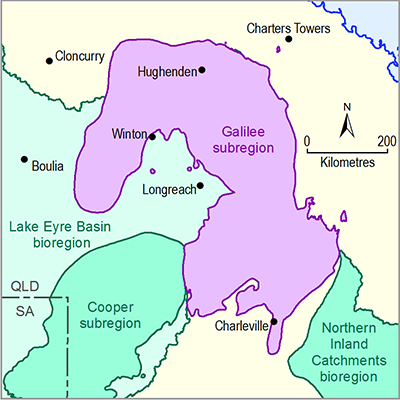- Home
- Assessments
- Bioregional Assessment Program
- Galilee subregion
- 2.6.2 Groundwater numerical modelling for the Galilee subregion
- 2.6.2.2 Review of existing models
- 2.6.2.2.1 Alpha and Kevin's Corner model review
URS (2012a, 2012b) and PB Pty Ltd (2012) provide summaries of the history of groundwater model development for the Alpha and Kevin’s Corner coal projects. For this report the model referred to here is the groundwater assessment model as detailed in URS (2012a, 2012b). The groundwater assessment model was utilised for the prediction of groundwater inflows, changes to groundwater levels, and to assess potential impacts to bores and environmental assets (URS, 2012b) for the Alpha and Kevin’s Corner coal projects. The groundwater assessment model has three major components: a steady-state regional-scale model that includes the Alpha and Kevin’s Corner coal projects; a local-scale transient model that focuses on the Alpha test pit; and the predictive inflow into the mine simulations, which utilised the regional-scale model framework. Increases in conductivity caused by fracturing due to stress release following tunnelling above longwall panels in the Kevin’s Corner Mine were applied to the C seam and CD interburden. Changes in recharge due to storage of mine waste rock in open-cuts, which is done as part of progressive open-cut rehabilitation, were not included.
The steady-state groundwater assessment model and predictive inflow simulations cover an area of some 118.5 km × 45.6 km and is comprised of 100 m × 200 m asymmetrical cells in the mine areas with coarser-scale cells outside the mine areas. The transient groundwater assessment model was a local-scale model developed as a subdomain of the steady-state model, with 20 m × 20 m grid cells focused on the Alpha test-pit area.
The model contains 11 layers. The Cenozoic units, Moolayember Formation, and Clematis Group are all grouped into the uppermost model layer. This is not ideal as the Moolayember Formation regional aquitard is grouped with the underlying and overlying aquifers. As a result the model cannot simulate vertical flow between these units. Layers 2 and 3 represent the Rewan Group. Layers 4 to 10 represent the upper Permian coal measures, while model layer 11 represents the Joe Joe Group.
Constant-head boundaries were assigned to the southern and northern edges of the modelling domain. The western model boundary coincides with the Great Dividing Range and is assigned as a no-flow boundary (URS, 2012b), as was the contact between the Colinlea Sandstone and Joe Joe Group. It was assumed that the model edges are far enough away from the mine that no mine dewatering induced water level drops will occur at the edge of the model domain for the duration of simulated mining in the model.
A uniform recharge value of 0.037 mm/year was applied across the model area to shallow aquifers in alluvium only as there did not appear to be any correlation between rainfall events and groundwater level fluctuations in the underlying upper Permian coal measures (URS, 2012a).
This local-scale transient model utilised various datasets collated during dewatering of the Alpha test pit for a transient calibration while the steady-state regional-scale model was calibrated using groundwater level measurements taken prior to commencement of dewatering of the Alpha test pit. For the predictive groundwater inflow simulations, calibrated hydraulic conductivities were obtained from the steady-state regional model while calibrated storativity values were utilised from the local-scale transient groundwater model. Sensitivity and uncertainty analyses were undertaken utilising calibrated parameters for both steady-state and transient model runs.
From the predictive groundwater inflow simulation runs, the best-case estimate for the amount of cumulative groundwater inflow into the mines for both projects ranged from 2.13 to 8.4 GL/year over a 30-year period. Predictive groundwater simulations run out for 300 years.
The groundwater inflow simulations overall predict minimal drawdowns for groundwater in the alluvium, as the shallow aquifers are not hydraulically connected to deeper groundwater systems. Localised drawdowns in alluvium may occur if groundwater is within 100 m of the open-cut. Regional groundwater flow patterns would not be markedly altered by the final Alpha and Kevin’s Corner mine voids. The risk of induced groundwater flow towards the mines from the overlying Clematis Group and Great Artesian Basin (GAB) aquifers is considered small.

Product Finalisation date
- 2.6.2.1 Methods
- 2.6.2.2 Review of existing models
- 2.6.2.2.1 Alpha and Kevin's Corner model review
- 2.6.2.2.2 Carmichael model review
- 2.6.2.2.3 China First model review
- 2.6.2.2.4 China Stone model review
- 2.6.2.2.5 South Galilee model review
- 2.6.2.2.6 Galilee Basin hydrogeological model review
- 2.6.2.2.7 Suitability of existing groundwater models
- References
- Datasets
- 2.6.2.3 Model development
- 2.6.2.4 Boundary and initial conditions
- 2.6.2.5 Implementation of the coal resource development pathway
- 2.6.2.6 Parameterisation
- 2.6.2.7 Observations and predictions
- 2.6.2.8 Uncertainty analysis
- 2.6.2.9 Limitations and conclusions
- Citation
- Acknowledgements
- Currency of scientific results
- Contributors to the Technical Programme
- About this technical product
